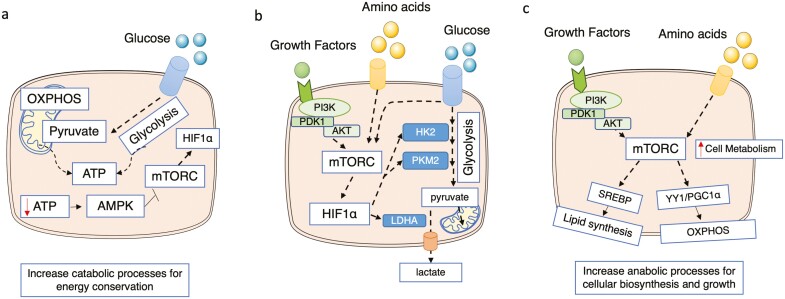FIGURE 2.
The interplay between the AMPK, mTORC1, and HIF-1α signaling pathways. (A) During ATP depletion, AMPK is activated, increasing catabolic processes, which generate ATP, and reducing anabolic processes, which utilize ATP, to restore energy homeostasis. The AMPK activation blocks the activity of mTORC1, a metabolic regulator that promotes cellular anabolism. As HIF-1α levels are increased by mTORC1 in many cells, the activation of AMPK will also repress HIF-1α signaling. (B) Activation of mTORC1 through the signaling pathways PI3K/AKT/mTORC1 and nutrient availability promotes glycolysis through the expression of HIF-1α dependent glycolytic genes. mTORC1 activates HIF-1α signaling, which impacts glycolysis. For instance, HIF-1α upregulates HK2, PKM2, and glucose transporters such as SLC2A1 (Glut1). LDHA, an enzyme responsible for the conversion of pyruvate into lactate, is also regulated by HIF-1α. (C) mTORC1 senses changes in growth factors and amino acids. Once activated, mTORC1 promotes an increase of cell metabolism by regulating glycolysis (see B), OXPHOS through an increase of the YY1/PGC1α axis, and lipid metabolism through the regulation of SREBP transcription factors. AKT indicates also known as protein kinase B; HK2: hexokinase 2; LDHA: lactate dehydrogenase A; SLC2A1, solute carrier family 2 member 1 (also known as Glut1); PGC1α: peroxisome-proliferator-activated receptor coactivator 1α; PI3K, phosphoinositide 3-kinase; YY1: transcription factor yin-yang 1.

